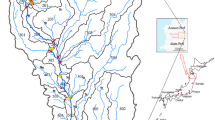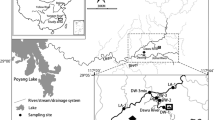Abstract
Heavy metal pollution of a mining-impacted river—the Wenyu River—and a short section of the river it joins, the Luo River, were investigated after heavy rainfall following a dry season in March 2015 and during a normal flow season in May 2015. Water samples were collected during these two periods, and sediment samples were obtained in May as the rain washed out the sediments in March. The results showed the following: (1) The Wenyu River was severely polluted by acid mine drainage from an open-pit molybdenum (Mo) mine, and the major pollutants in the water according to Chinese national standard values were acid (pH), sulfate, Cu, Zn, Mn, Ni, and Cd. The major pollutants in the sediment were Cu, Zn, and Cd, as indicated by the geoaccumulation index and potential ecological risk index. (2) The major pollutants in the water were naturally attenuated along the river and met the national standard values after joining the Luo River, except Mn in both water samples and Cd in the samples after rain in March. The major pollutants in the sediments showed an increasing tendency along the Wenyu River and Luo River. (3) The heavy rainfall following the prolonged dry season increased acid and heavy metal contamination in the river, which might be attributed to the dissolution of efflorescent salts and the weathering and erosion of mining residues. Thus, the first heavy rain following a dry season should receive particular attention from mining enterprises and regulators. Several mitigation options and recommendations are also discussed.






Similar content being viewed by others
Availability of data and material
All data generated and analyzed during this study are included in this published article and its electronic supplementary material.
References
Affandi FA, Ishak MY (2019) Impacts of suspended sediment and metal pollution from mining activities on riverine fish population—a review. Environ Sci Pollut Res 26:16939–16951
Anawar HM (2013) Impact of climate change on acid mine drainage generation and contaminant transport in water ecosystems of semi-arid and arid mining areas. Phys Chem Earth 58–60:13–21
APHA (American Public Health Association), (1998) Standard methods for the examination of water and wastewater, 20th edn. APHA, Washington, DC
Balintova M, Singovszka E, Vodicka R, Purcz P (2016) Statistical evaluation of dependence between pH, metal contaminants, and flow rate in the AMD-affected Smolnik Creek. Mine Water Environ 35:10–17
Byrne P, Runkel RL, Walton-Day K (2017) Synoptic sampling and principal components analysis to identify sources of water and metals to an acid mine drainage stream. Environ Sci Pollut Res 24:17220–17240
Byrne P, Wood PJ, Reid I (2012) The impairment of river systems by metal mine contamination: a review including remediation options. Crit Rev Env Sci Tec 42:2017–2077
Cánovas CR, Riera J, Carrero S, Olías M (2018) Dissolved and particulate metal fluxes in an AMD-affected stream under different hydrological conditions: The Odiel River (SW Spain). CATENA 165:414–424
Cidu R, Frau F, Pelo SD (2011) Drainage at abandoned mine sites: natural attenuation of contaminants in different seasons. Mine Water Environ 30:113–126
Ciszewski D, Grygar TM (2016) A Review of Flood-Related Storage and Remobilization of Heavy Metal Pollutants in River Systems. Water Air Soil Pollut 227:239
Dold B (2014) Evolution of acid mine drainage formation in sulphidic mine tailings. Minerals 4:621–641
Gao YF, Xu YN, Zhang JH (2018) Evaluation of Cd pollution of a molybdenum ore area in Dongchuan River basin of the Qinling Mountain. Geol Bull China 37:2241–2250 (in Chinese with English abstract)
Gemici Ü (2008) Evaluation of the water quality related to the acid mine drainage of an abandoned mercury mine (Alaşehir, Turkey). Environ Monit Assess 147:93–106
Grande JA, de la Torre ML, Santisteban M, Fortes JC (2018) Hydrochemical characterization and evaluation of the impact of AMD processes on river basin areas in the Iberian Pyrite Belt. Water Policy 20:146–157
Hakanson L (1980) An ecological risk index for aquatic pollution control: a sediment to logical approach. Water Res 14:975–1001
Hughes TA, Gray NF (2011) Effectiveness and sustainability of active and passive systems for the treatment of acid mine drainage and the recovery of metals: A review. Mine drainage and related problems. Nova Science Publishers Inc, New York, pp 1–70
Lecomte KL, Maza SN, Collo G, Sarmiento AM, Depetris PJ (2017) Geochemical behavior of an acid drainage system: the case of the Amarillo River, Famatina (La Rioja, Argentina). Environ Sci Pollut Res 24:1630–1647
Lee JY, Choi JC, Lee KK (2005) Variations in heavy metal contamination of stream water and groundwater affected by an abandoned lead-zinc mine in Korea. Environ Geochem Health 27:237–257
Lei M, Du XL, Zhang F (1994) The comprehensive utilization of water resource in Jinduicheng molybdenum corporation. China Molybd Ind 18:8–10 (in Chinese)
Li HY, Ye HS, Wang XX, Yang L, Wang XY (2014) Geology and ore fluid geochemistry of the Jinduicheng porphyry molybdenum deposit, East Qinling, China. J Asian Earth Sci 79:641–654
Luís AT, Grande JA, Durães N, Dávila JM, Santisteban M, Almeida SFP, Sarmiento AM, de la Torre ML, Fortes JC, da Silva EF (2019) Biogeochemical characterization of surface waters in the Aljustrel mining area (South Portugal). Environ Geochem Health 41:1909–1921
Marrugo-Negrete JL, Urango-Cardenas ID, Núñez SMB, Díez S (2014) Atmospheric deposition of heavy metals in the mining area of the San Jorge river basin, Colombia. Air Qual Atmos Health 7:577–588
Müller G (1969) Index of geoaccumulation in sediments of the Rhine River. Geol J 2:108–118
Nemerow NL (1974) Scientific stream pollution analysis. McGraw Hill Book Company, New York
Nordstrom DK (2009) Acid rock drainage and climate change. J Geochem Explor 100:97–104
Pak G, Hong U, Jung M, Kim H, Han K, Mallari KJB, Kim S, Kim Y, Yoon J (2015) Characteristics of hydrochemical variations and contaminant load during rainfall in an acid mine drainage-impacted watershed, Korea. Desalin Water Treat 54:3511–3522
Pan AF, He Y, Ma RY (2004) Zoning of environmental geochemistry in Shaanxi province. Adv Earth Sci 19:439–443 (in Chinese with English abstract)
Park I, Tabelin CB, Jeon S, Li XL, Seno K, Ito M, Hiroyoshi N (2019) A review of recent strategies for acid mine drainage prevention and mine tailings recycling. Chemosphere 219:588–606
Runkel RL, Kimball BA, Nimick DA, Walton-Day K (2016) Effects of flow regime on metal concentrations and the attainment of water quality standards in a remediated stream reach, Butte, Montana. Environ Sci Technol 50:12641–12649
Sarmiento AM, Nieto JM, Olías M, Cánovas CR (2009) Hydrochemical characteristics and seasonal influence on the pollution by acid mine drainage in the Odiel river Basin (SW Spain). Appl Geochem 24:697–714
SEPAC (State Environmental Protection Administration of China), (1997) Soil quality-determination of lead, cadmium-graphite furnace atomic absorption spectrophotometry (GB/T 17141–1997). China Environmental Science Press, Beijing
SEPAC (State Environmental Protection Administration of China) (2002) Environmental quality standards for surface water (GB 3838–2002). SEPAC, Beijing
Shi CY, Liang M, Feng B (2016) Average background values of 39 chemical elements in stream sediments of China. Earth Sci 41:234–251 (in Chinese with English abstract)
Streten-Joyce C, Manning J, Gibb KS, Neilan BA, Parry DL (2013) The chemical composition and bacteria communities in acid and metalliferous drainage from the wet–dry tropics are dependent on season. Sci Total Environ 443:65–79
Swinkels LH, Van de Ven MWPM, Stassen MJM, Van der Velde G, Lenders HJR, Smolders AJP (2014) Suspended sediment causes annual acute fish mortality in the pilcomayo river (bolivia). Hydrol Process 28:8–15
Turunen K, Räsänen T, Hämäläinen E, Hämäläinen M, Pajula P, Nieminen SP (2020) Analysing contaminant mixing and dilution in river waters influenced by mine water discharges. Water Air Soil Pollut 231:317
Wang B (2016) Jinduicheng south open phase II project of soil and water loss disaster situation and counter measures research. Master dissertation, Chang’an University, Xi’an, China
Wang JT, Xie J, Zhang YQ (2006) Effect of waste rock eluviation on water environment. J Earth Sci Environ 28:92–96 (in Chinese with English abstract)
Wang LF (2015) North of jinduicheng mine soil and water loss disaster situation investigation and the regularity of erosion research. Master dissertation, Chang’an University, Xi’an, China
Wang LY, Yang C (2018) Research on secondary pollution for exploitation of waste rock at molybdenum ore. Shanxi Archit 44:189–190 (in Chinese with English abstract)
Xu ZQ, Ni SJ, Tuo XG (2008) Calculation of heavy metals toxicity coefficient in the evaluation of potential ecological risk index. Environ Sci Technol (hubei, China) 31:112–115 (in Chinese with English abstract)
Acknowledgements
Authors are thankful to Prof. Kai-bo Wang and Dr. Yan Zhao for their assistances in sample collections and chemical analyses.
Funding
This work was funded by the Special Support Plan for Leading Talent of Shaanxi Province, China.
Author information
Authors and Affiliations
Contributions
D. C. contributed to formal analysis and investigation, data curation and visualization, and writing—original draft preparation. Y.-P. C. was involved in conceptualization, methodology, writing—review and editing, supervision, and funding acquisition. Y. L. contributed to methodology, formal analysis and investigation, and writing—review and editing.
Corresponding authors
Supplementary Information
Below is the link to the electronic supplementary material.
Rights and permissions
About this article
Cite this article
Chen, D., Chen, Yp. & Lin, Y. Heavy Rainfall Events Following the Dry Season Elevate Metal Contamination in Mining-Impacted Rivers: A Case Study of Wenyu River, Qinling, China. Arch Environ Contam Toxicol 81, 335–345 (2021). https://doi.org/10.1007/s00244-021-00870-y
Received:
Accepted:
Published:
Issue Date:
DOI: https://doi.org/10.1007/s00244-021-00870-y




